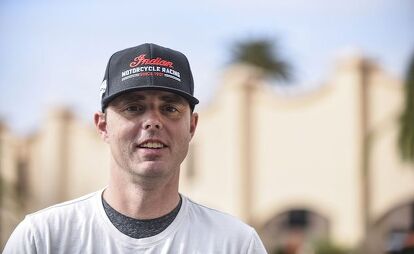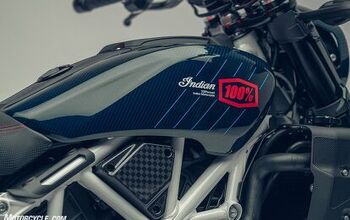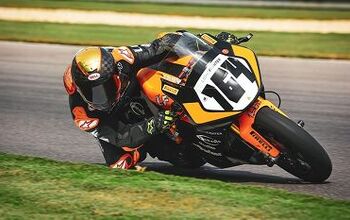MO Interview: Reid Wilson, Director of Marketing for Indian Motorcycle
Mission: To Boldly Go where no (major) American motorcycle manufacturer has gone in a long, long time
Indian summoned the moto-press to San Diego a couple of weeks ago to introduce another new model that’s embargoed until about April. One of the most interesting parts of this particular junket were the remarks by Reid Wilson, Indian’s 37-year old Marketing Director. Before coming to Indian three years ago, Wilson worked as a brand manager for Miller/Coors, and before that he was riding Briggs & Stratton-powered minibikes from the time he was a toddler. I corralled him at the bar for further explication.
MO: So, not in the next five years but in the next two or three years, you guys have some cool things coming down the pipeline, you said. Can you tell us more?
Reid: Yeah, so the first thing is reiterating our commitment to the brand Indian, investing in Indian, living up to the Indian name – so that means new riders, new segments, new bikes – outside of cruiser/bagger/touring, all within the next two to three years.
MO: I heard you say you want to attack market segments where American manufacturers haven’t been in a long time?
Reid: Yes. If you look back to the days of the original Indian, they were one of the most innovative, boundary-breaking companies, winning the Isle of Man and all that. That’s a helluva legacy to live up to and we’re focused on that, so that means doing new things that American motorcycle manufacturers aren’t doing right now. We’re really excited about doing that and, honestly, it’s coming a lot sooner than people think. I don’t want to say it’s coming tomorrow, but it is coming in the next few years. It’s an exciting time to be part of the brand, and an exciting time to be a motorcyclist in America.
MO: What kind of bikes do you like, and the other guys at Indian? What’s parked out front at the factory?
Reid: As enthusiasts, we ride everything. I grew up racing and riding dirtbikes, and transitioned from that to a streetfighter.
MO: Hah! A Buell!?
Reid: No, well, I don’t want to talk about other brands, but it was a Triumph, a performance bike. I know you were talking to Josh, Josh [Katt] is an engineer and our product manager, and he does track days on a Buell [an 1125CR], so we ride everything. Now I have an Indian, I have multiple Indians and I love riding Indians – but in this industry you have to ride everything and see what everybody’s doing. But we are all enthusiasts and we’re all interested in all aspects of motorcycling. That’s who we are.
MO: Do you think it will make it easier that Victory’s not there anymore? Was there competition between the brands?
Reid: Yeah, well there’s only a certain amount of investment available in a company, and so the focus on Indian will help the brand significantly. Now there’s additional investment coming to Indian, there’s additional people, there’s additional overall effort and push behind it, and the overall commitment behind it is very, very strong and very long-term… and I’m excited I’ll be seeing a lot of you all over the next few years, there’ll be a lot of times we’ll get to talk.
MO: Well then let me ask you this while I’m thinking about it: A lot of people are always asking me, ‘When are we going to get a two-stroke performance motorcycle?’
RD: (laughing incredulously) A two-stroke?
MO: Yeah a two-stroke, a sportbike powered by something like the 800 Twin Polaris uses in snowmobiles, powerful and light? People write us all the time. It seems like the technology is there, especially at Polaris?
Reid: I think the two-stroke market is covered by existing manufacturers that do it pretty well.
MO: Right, KTM 300s, but I’m talking streetbike.
Reid: Well I’m not too familiar with emissions regulations and all that, but I think there are significant barriers to doing that, on the street. And as a dirtbike guy, I don’t know if two-stroke characteristics are what you really want on the street… a little unruly… great in the woods or on a motocross track, but I don’t know about the street…
MO: I assume you’d tame it all down with ride modes and traction control and all that.
Reid: At that point you might as well go with what you already have. I dunno, two-stroke, a tame two-stroke? Have you ridden a tame two-stroke that’s fun?
MO: Um yeah, I’ve ridden a KTM 300 or two off-road, they run really good even at low rpm, great torque – and monster power on top.
Reid: Honestly I haven’t ridden a modern two-stroke, I grew up riding two-strokes and most of them were like an on/off switch. They were fun but not exactly friendly.
MO: What part of the world did you grow up in?
Reid: I grew up in Washington state. Yeah, muddy technical dirt, woods…
MO: And skiing in the winter…
Reid: No skiing, just riding motorcycles, that’s all I did. Yeah, winter, too. I remember melting gloves to the exhaust pipe because you’re so cold you’d grab the exhaust pipe to get warm… that was 20 years ago, maybe gloves are better now?
MO: Wow, you’re a serious motorcycle guy.
Reid: Ahh, I’ve met some serious motorcycle guys. I like motorcycles but I’m never gonna stack myself up against guys who’ve gone around the world, or our flat-track team that’s won everything. It’s like being a musician; you think you’re a good musician until you play with somebody really good. You think you’re a good motorcyclist until you see somebody professional, and then you’re quite humbled.
MO: So you’re involved with the flat-track team too?
Reid: Yes. Brad [Baker] and Bryan [Smith] and Jared [Mees]; I’ve been part of that since the beginning along with our product team, it’s been a lot of fun.
MO: Flat-track should be fun this year, Harley’s new bike and your new FTR750.
Reid: Yeah, there’s a lot of unknowns; they have a new bike, we have a new bike. I’m excited to see it on the track and I’m nervous, it’s been a lot of years of effort – well not that long ago – but it’s been a huge effort to get a bike from nothing this time last year, to what is it, February? We didn’t even have a motor yet. We had a drawing on a piece of paper at this point last year.
MO: Wow, the SwissAuto people knocked it out just like that? With your encouragement and help of course.
Reid: They know what they’re doing, and we’ve been part of that as well, designing the chassis and all the other aspects of the motorcycle. They’ve been great partners with us and they’re enthusiasts as well, who designed GP engines back in the day and Formula 1 engines, so they know what they’re doing. I’m far from an engineer but it’s been a really quick effort. It’s nerve-wracking and fun to see the race happen in March. I can’t wait for it! Two American brands going at it… but I’m confident, we went and found the best riders. Anybody who follows flat-track can’t fault the riders we signed. Now it’s on us to give them a bike they can win on, and I think we’re doing that.
MO: Will we see an FTR streetbike of some kind first, or a plastic-wrapped sportbike first?
Reid: Ever since the FTR came out, the guys did such a beautiful job designing it, it’s just an awesome motorcycle – whatever your interest is in motorcycles, whether you love scooters or touring bikes or dirtbikes – you see that bike and there’s something about it that’s magnetic. So, it would really make sense to do something like that for the street I would think.
MO: So does that mean you’re doing it?
Reid: It would just make a ton of sense, wouldn’t it? If you go on the internet, and everybody says, ‘Hey why don’t you build that?’, then it would just make a ton of sense to do it. Obviously it’s not that easy to take a race-only engine, what people don’t realize is when you shorten the development time like that to build the FTR, to build a streetbike motor it takes years and years of engineering and effort and money… it’s not like you can design a race motor in a year, then let’s put it on the street! There’s a lot of work and a lot of diligence that goes into a street motor to last thousands of miles, and all of it takes time… but it does make a ton of sense.
More by John Burns


































Comments
Join the conversation
If I'm not mistaken (MO correct me if I'm wrong), there are three segments of motorcycles that are doing well: baggers, ADV, and 350cc-range bikes. Indian has baggers, and they can continue parts-bin model development ad infinitum. The ADV market is a possibility; Ducati does well with their VTwin engined MultiStrada line. Perhaps the Scout/Octange engine could be re-tasked. I don't know how they could compete in the 350cc market. It's fully stocked and the entry cost vs. profit margin is very close.
This is pure conjecture; the only thing Reid really said was they're likely going to produce an "FTR streetbike." I have no idea what that means.
INDIAN FOUR!!!